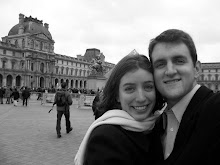.jpg) On a weekend trip to visit some church members near Liege, Daniel and I decided to spend the night in Brussels, Belgium. Daniel had been there before and had always wanted to show me this beautiful city. Belgium is only about six hours away, so we left early Saturday morning and packed a picnic lunch. We enjoyed services, a huge meal, and much talking with a group near Huy, Belgium. That evening we drove over to Brussels. On the way we passed a nuclear power plant that was extremely close to the road. We reached Brussels in good time, but it was definitely a challenge to find the hotel, even with a map. The street signs are posted on the buildings (if they are even there), the city is dimly lit, the road system chaotic, and the names of the streets were in Flemish which was different than the names we had on our map on my laptop. We finally found the hotel, changed, and went for a long walk around the city. There are huge, ancient, beautiful buildings and places of interest all around which were lit and in full glory that evening. It was a clear and cool night so we enjoyed the walk, though we encountered much litter and bad smells on the streets.
On a weekend trip to visit some church members near Liege, Daniel and I decided to spend the night in Brussels, Belgium. Daniel had been there before and had always wanted to show me this beautiful city. Belgium is only about six hours away, so we left early Saturday morning and packed a picnic lunch. We enjoyed services, a huge meal, and much talking with a group near Huy, Belgium. That evening we drove over to Brussels. On the way we passed a nuclear power plant that was extremely close to the road. We reached Brussels in good time, but it was definitely a challenge to find the hotel, even with a map. The street signs are posted on the buildings (if they are even there), the city is dimly lit, the road system chaotic, and the names of the streets were in Flemish which was different than the names we had on our map on my laptop. We finally found the hotel, changed, and went for a long walk around the city. There are huge, ancient, beautiful buildings and places of interest all around which were lit and in full glory that evening. It was a clear and cool night so we enjoyed the walk, though we encountered much litter and bad smells on the streets..jpg)
.jpg)
Our favorite spot, and where we spent the most time, was the central market square, known by “Grand-Place” and “de grote Markt” depending on which language you are speaking. I think it is the most beautiful square I’ve seen so far in Europe. During the Middle Ages it was a marketplace surrounded by small wooden houses, and later replaced in the 14th century as rich and powerful families built stone mansions. The square turned into the city’s political center where meetings and executions took place and where dukes/kings/emperors were received. The town hall was completed in 1455. THEN the square was destroyed by bombs in 1695 (by order of Louis XIV as a reprisal of a lost battle in Namur, South Belgium). So they had to rebuild all the stone houses (most are elaborately decorated medieval guild houses) and the town hall entirely reconstructed.
.jpg) Across the square from the town hall is the King’s House (“La maison du roi” in French, “Het Broodhuis” in Dutch). In the 13th century this was the site of an old wooden building where bakers sold their bread, later replaced by a stone building, later used for administrative purposes, rebuilt in Gothic style in 1515, later damaged in bombings of 1695, restored, and ultimately restored to the way it is now, in 1860. It is now the site of the City Museum of Brussels. Below left: Saint Gudula Cathedral.
Across the square from the town hall is the King’s House (“La maison du roi” in French, “Het Broodhuis” in Dutch). In the 13th century this was the site of an old wooden building where bakers sold their bread, later replaced by a stone building, later used for administrative purposes, rebuilt in Gothic style in 1515, later damaged in bombings of 1695, restored, and ultimately restored to the way it is now, in 1860. It is now the site of the City Museum of Brussels. Below left: Saint Gudula Cathedral..jpg)
.jpg)
There is a curiously famous statue that we also visited, named the Mannekin Pis. It is a surprisingly small fountain statue, of a little boy tinkling. The official origin is traced back to 1619, but records indicate that it was there a lot earlier. Over the centuries the little statue has been hidden to protect him from bombs of invading armies, stolen several times, and though he was au-natural when we saw him, he is often dressed, and has over 600 costumes (kept at the City Museum). I found a website that shows some of the costumes: http://www.ilotsacre.be/images/virtualvisit/manneken_pis.htm. It is quite funny. We found Brussels to be both an interesting and entertaining city.
.jpg)
.jpg)
.jpg)
No comments:
Post a Comment